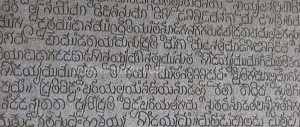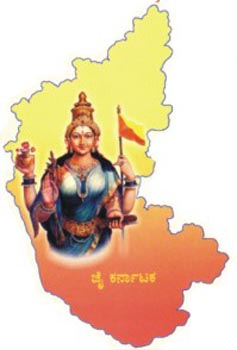Kannada, the one language which resides in
the heart of every Kannadiga. The glory of this language dates back to
centuries and though it is used only in the state of Karnataka, the richness of
this language has spread across the world. As we are celebrating the Rajyotsava
festival as a mark of the formation of Karnataka state.
Name: The word “Karnataka” is derived from the Kannada words “Karu”
and “Nadu” which means “Elevated Land”.
Existence: On 1st November 1956, Karnataka was created by the
States Reorganization Act and named it as State of Mysore. In 1973, it was
renamed to Karnataka.
Boundary: Karnataka is surrounded by the Arabian Sea, Laccadive sea,
Goa, Maharashtra, Andhra Pradesh, Tamil Nadu and Kerala.
Population: The total population of Karnataka is 61,130,704. Karnataka
holds 9th position in population wise.
Land
Area: The Land area of Karnataka is 191,791 sq. km.
Karnataka holds 8th position in area wise.
Language: The Official Language of Karnataka is Kannada.
Literacy: The Literacy Ratio is 75.60%.
City: Its Capital City is Bangalore. Bangalore is also the largest
city of Karnataka.
District: It has 30
districts located here.
Connectivity: Karnataka
is well connected in roadways, railways and airways. Karnataka has some
domestic airports also. These are in Bangalore, Mangalore, Hubli, Belgaum etc.
Festivals: Ganesh Chaturthi, Basava Jayanthi, Deepavali, Ramzan, Ugadi,
etc. are some of the important festivals celebrated in Karnataka.
Religion: In Karnataka, 83% and 11% population are Hindu and Muslim
respectively and remaining others includes Christian, Jain and Buddhist, etc
Unknown facts about Kannada and Karnataka
- Kannada is one of the oldest Indian languages
- Kittur Rani Chennamma (1778-1829): Queen of the princely state of Kittur she was the first woman to lead an armed rebellion against British governance and kappa tax in 1824. This was more than three decades before Rani Lakshmibai of Jhansi in 1857, after the British refused to recognize her adopted heir Shivalingappa. She was captured and imprisoned in Bailhongal fort where she died in 1829. Rani Chennamma’s statue was unveiled in the Indian Parliament complex by President Pratibha Patil.
- Karnataka Khadi Gramodyoga Samyukta Sangha (KKGSS): The KKGSS, in Bengeri in Hubli, is the only unit in India that is authorized to manufacture and supply the Flag of India. Set up in 1957, the khadi flag conforms to the Bureau of Indian Standards benchmarks.
- The Kannada language is as old as 2000 years
- Purandara Dasa (1484-1564): Known as the “Father of Carnatic Music”, he was born near Tirthahalli in Shivamogga (Shimoga) district. He systematized the entire system of teaching Carnatic music that is followed to this day. He introduced the basic scale for music instruction (composing Raga Mayamalavagowla) and fashioned a series of graded lessons. He fused bhava, laya and raga in his compositions. The standardisation of varna mettus has been attributed entirely to Purandara Dasa. About 1000 of his compositions are still extant. His influence on Hindustani music too has been profound. For example, Tansen’s teacher, Swami Haridas, was Purandara Dasa’s disciple.
- Kannada is the only Indian language for which a foreigner Ferdinand Kittel wrote a Dictionary
- Sir M Visvesvaraya (1860-1955), Bharat Ratna awardee: He was born in Muddenahalli village about 40 miles from Bengaluru. His birthday 15th September is celebrated as Engineer’s Day in India. He was a pre-eminent engineer, scholar, statesman and also the Diwan of the princely state of Mysore from 1912-1918. He was the chief engineer for the KRS Dam in Mysore, designed the flood protection system for Hyderabad, Khadakvasala (Pune) and Gwalior and a sea erosion protection system for Vishakapatnam. He also set up the UVCE Engineering college in Bengaluru in 1917, the Mysore Soap Factory, the Parasitoide Laboratory, the Mysore Iron & Steel Works (now known as Visvesvaraya Iron and Steel Limited) in Bhadravathi, the Sri Jayachamarajendra Polytechnic Institute, the Bangalore Agricultural University, the State Bank of Mysore, The Century Club, Mysore Chambers of Commerce and numerous other industrial ventures. He encouraged private investment in industry during his tenure as Diwan of Mysore. He was instrumental in charting out the plan for road construction between Tirumala and Tirupati.
- When the Kannada literature “Kavirajamarga” was written by Amogavarsha, English was a baby in the cradle and Hindi was not born at all. So called International language -- English does not have its own Script. English is written in "ROMAN" .So called National Language -- Hindi does not have its own script. Hindi is written in "Devanagari". Though Tamil has a script, logically it is imperfect -- as common letters are used for many pronunciations. KANNADA is as old as 2000 years. You can write what you speak and you can read what you write.
- Akashvani (All India Radio): This is what the All India Radio is officially known as since 1956. The term Akashvani was coined by MV Gopalswamy of Mysore after setting up the nation’s first private radio station in his residence, “Vittal Vihar” in 1936. Akashvani means celestial announcement. The word, of Sanskrit origin, is often found in Hindu mythology. When the gods wished to say something, an akashvani occurred. Literally, “akash” means “sky” and vani means “sound” or “message”. Thus, Akashvani seemed suitable for a radio broadcaster and was later adopted by the All India Radio after independence.
- Vijayanagara Empire (1336-1646): Hampi (a UN World Heritage Site) belongs to this and has the most famous set of archaeological remnants. It has lasted longer than the Mughal Empire and covered an area that was comparable if not larger.
- Karnataka
State:
The state of Mysore state was formed on November 1st 1956 after the States Reorganization Act. Effective from 1973, the state became known as Karnataka.
- Kannada is 99.99% perfect logically and scientifically
- Devanahalli: This is now the site of the new Bengaluru airport and is the birthplace of Tipu Sultan.
- SHRI VINOBA BHAVE called KANNADA script as QUEEN OF WORLD SCRIPTS "Vishwa Lipigala Raani - KANNADA”
- Chanakya or Kautilya’s Arthashastra (one of the world’s oldest and finest treatises on statecraft, economic policy and military strategy written in 4th century BC): The oldest surviving manuscript of the Arthashastra is in the Oriental Research Institute set up as the Mysore Oriental Library in 1891. Scholar and Indologist, Rudrapatna Shamasastry, discovered the manuscript in its original Grantha script in 1905, translated it into Sanskrit in 1909 and into English in 1915. This gave Indians and the world a masterpiece.
- The only Indian author who got maximum awards for literature is Shri Kuvempu who is a proud Kannadiga
- Kannada is the only Indian language which
got maximum GyanaPeetha Awards.
Kannada -8, Hindi -6, Telugu -2, Malayalam -3 and Tamil – 2
- Kannada is one of the Indian languages to feature in Wikipedia logo
- Charition mime, an ancient greek play ( In 2nd century) had used Kannada phrases
- Ragale Saahithya can be seen only in KANNADA which is of a rare and different kind of literature.
- KANNADA Chandassu (shatpadis) out pared all other languages.



























No comments:
Post a Comment